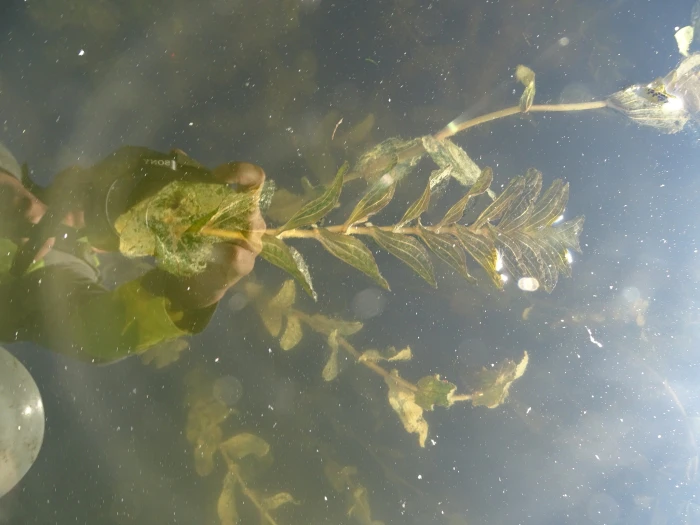Clasping-Leaf Pondweed
(Potamogeton perfoliatus)
Clasping-Leaf Pondweed (Potamogeton perfoliatus)
/
/

© Grzegorz Grzejszczak
CC BY-SA 4.0
Image By:
© Grzegorz Grzejszczak
Recorded By:
Copyright:
CC BY-SA 4.0
Copyright Notice:
Photo by: © Grzegorz Grzejszczak | License Type: CC BY-SA 4.0 | License URL: http://creativecommons.org/licenses/by-sa/4.0/ | Uploader: grzegorz_grzejszczak | Publisher: iNaturalist |

























Estimated Native Range
Climate Requirements
| • Precipitation | 65" - 78" |
| • High Temp. | 66°F - 75°F |
| • Low Temp. | 6°F - 34°F |
Summary
Potamogeton perfoliatus, commonly known as Clasping-leaf Pondweed, is a perennial aquatic herb native to a wide range of freshwater habitats including lakes, slow-moving rivers, and ponds in North America, Europe, Asia, Australia, and Africa. It is absent from South America and Antarctica. This species typically has round stems that can grow up to 10 feet long and submerged leaves that clasp the stem, giving it its common name. The leaves are olive-green to reddish-brown and somewhat transparent. Clasping-leaf Pondweed blooms with small, inconspicuous greenish flowers from June to September, which are wind-pollinated and often go unnoticed.
Clasping-leaf Pondweed is valued for its role in aquatic ecosystems, providing habitat and food for fish and invertebrates. It is also used in aquariums and ponds for its oxygenating properties and for controlling algae by competing for nutrients. This plant prefers full sun but can tolerate partial shade, and it thrives in a wide range of water conditions, from soft to hard and from acidic to alkaline. It can be propagated by seed or by dividing rhizomes or cuttings. While generally not problematic, it can be sensitive to high nutrient levels, which may lead to overgrowth of algae that can shade and outcompete the pondweed.CC BY-SA 4.0
Clasping-leaf Pondweed is valued for its role in aquatic ecosystems, providing habitat and food for fish and invertebrates. It is also used in aquariums and ponds for its oxygenating properties and for controlling algae by competing for nutrients. This plant prefers full sun but can tolerate partial shade, and it thrives in a wide range of water conditions, from soft to hard and from acidic to alkaline. It can be propagated by seed or by dividing rhizomes or cuttings. While generally not problematic, it can be sensitive to high nutrient levels, which may lead to overgrowth of algae that can shade and outcompete the pondweed.CC BY-SA 4.0
Plant Description
- Plant Type:
- Height: 1-3 feet
- Width: 1-3 feet
- Growth Rate: Moderate
- Flower Color: Brown, Green
- Flowering Season: Summer, Fall
- Leaf Retention: Semi-deciduous
Growth Requirements
- Sun: Full Sun, Part Shade
- Water: High, Aquatic
- Drainage: Standing
Common Uses
Low Maintenance, Water Garden
Natural Habitat
Native to lakes, slow-moving rivers, and ponds in North America, Europe, Asia, and Africa
Other Names
Common Names: Clasping-Leaf Pondweed , Perfoliate Pondweed
Scientific Names: Potamogeton perfoliatus , Buccaferrea amplexicaulis , Peltopsis perfoliata , Potamogeton alatofructus , Potamogeton amplexicaulis , Potamogeton bupleuroides , Potamogeton fulvus , Potamogeton juzepczukii , Potamogeton loeselii , Potamogeton perfoliatus f. acutifolius
GBIF Accepted Name: Potamogeton perfoliatus